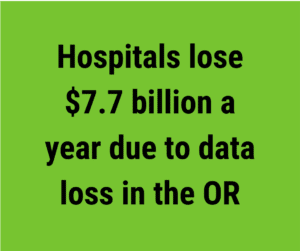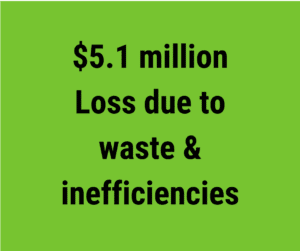Operating rooms, the primary revenue center for most hospitals, experience an exceptionally high rate of data loss — resulting in $7.7 billion lost income a year — vital, billable information that is not properly recorded into the appropriate systems within the hospital’s EHR and ERP. It is not hard to understand why.
Where’s the money gone? Capturing lost revenue in Surgical Rooms
There are many moving parts in a fully functioning OR: people, paperwork, equipment, instruments, and inventory. Getting everything recorded and documented in the exact format that ‘the system’ requires is not just difficult, in most cases it’s not even a high priority. 
It’s not hard to see why hospitals have trouble staying on top of documenting actual OR costs and expenditures. In fact, only 48% of medical implants and consumables used during surgery are reported, and therefore the rest – 52% are not charged.
Here’s how $10.3 million can be saved:

Inefficient systems can result in losses of up to $10.3 million, the main elements of which are:
- Loss of annual net revenue

- Uncertain inventory levels result in guesswork-based demand planning, leading to the purchase and maintenance of expensive on-hand inventory. The result: $5.1 million loss due to waste and inefficiencies.
- Liability risks and waste of expired & recalled items due to manual tracking. The result: $1.8million loss due to litigation and medical malpractice.

Hospitals can identify and fill their data gaps
A point of contention for many Hospital Managers is the difficulty in receiving full and timely reimbursement from insurance companies and government programs (such as Medicare and Medicaid).
One way to tackle this problem is to pay third-party service providers to manage the often convoluted ‘hoops’ that they must jump through before they see any sign of the reimbursement funds they are due. And of course, these service providers take their cut — money that could be better spent on staff or on improving patient care.
Another solution is to invest in software that pledges to optimize data management for reimbursement claims. The problem here is that the promise of better insurance claim outcomes is not always fulfilled, often because investments are made in indirect solutions that, in reality, do not provide the expected results.

“The commonly used technologies such as manual inputting and barcode scanning were not robust enough to solve the problem at its core.”
The right technology can drive change
Our evaluation of existing data collection products and systems for the OR led us to the conclusion that surgical units need a unique, dedicated data gathering and distribution solution. We realized that commonly-used methods, such as manual inputting and barcode scanning, are not robust enough to solve the issues at the core of the problem.
By combining several new technologies, such as machine learning and artificial intelligence (AI), innovative solutions are now available that fully address the problems we have outlined.
Snap & Go by IDENTI Medical, is one of those solutions. Based on optical image recognition, the Snap & Go image-capture device records and bills medical implants and consumables used during surgeries and other invasive and minimally invasive procedures. Even the smallest of items, including staples, sutures, and sterile orthopedic implants, can now be quickly documented and all associated data sent through to the hospital’s ERP and EHRs, where it is automatically logged.
During surgery a staff member simply places the consumed item under the Snap & Go camera and within a few seconds an image of the package is captured and the item identified. This is then routed through a global database with an advanced AI algorithm so that all relevant data is sent to the hospital’s EHR and billing software. This results in accurate, point of use charge capture and 100% reimbursement.
Snap & Go is powered by IDENTI’s advanced AI management software, which:
- Analyzes point-of-use data to boost revenue cycles using data optimization, transformation, integration, and enrichment with advanced prediction models.
- Synchronizes item information in EHR systems to conduct recall tracking and insurance reimbursement (batch no., manufacturer’s catalog no., serial no. and expiry date); fully complies with FDA UDI regulations.
- Maximizes data integrity with access to centralized manufacturers’ catalog item lists, hospital item lists, global catalogs, and information from additional online sources. Unrecognized items are identified by IDENTI’s back-office team and information is automatically fed back to the hospital to maintain a consolidated hospital item-master, reduce errors and avoid missed charges.
“Using optical image recognition can help hospitals and information technology companies, achieving operational and cost efficiencies while providing outstanding patient care”
Better patient care through operational efficiency

It’s a new dawn for the healthcare industry as it embraces new ways to use technology to solve its recurring issues. Hospitals and other healthcare institutions can now see ways to achieve operational and cost efficiencies that also contribute to the provision of outstanding patient care.
Hospitals are already investing in comprehensive data collection solutions to complement their existing ERP systems. Software companies, for their part, are invested in developing solutions that actually address their clients’ needs.
This trend is expected to intensify as more and more medical institutions recognize the benefits of automated, AI-powered data management.
OR and Procedure Room ‘Black Holes’ can now be a thing of the past.





